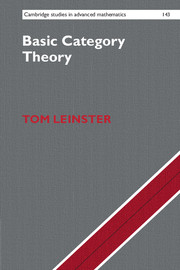July 27, 2014
Basic Category Theory
Posted by Tom Leinster
My new book is out!
Click the image for more information.
It’s an introductory category theory text, and I can prove it exists: there’s a copy right in front of me. (You too can purchase a proof.) Is it unique? Maybe. Here are three of its properties:
- It doesn’t assume much.
- It sticks to the basics.
- It’s short.
July 22, 2014
The Tenfold Way (Part 2)
Posted by John Baez
How can we discuss all the kinds of matter described by the ten-fold way in a single setup?
It’s bit tough, because 8 of them are fundamentally ‘real’ while the other 2 are fundamentally ‘complex’. Yet they should fit into a single framework, because there are 10 super division algebras over the real numbers, and each kind of matter is described using a super vector space — or really a super Hilbert space — with one of these super division algebras as its ‘ground field’.
Combining physical systems is done by tensoring their Hilbert spaces… and there does seem to be a way to do this even with super Hilbert spaces over different super division algebras. But what sort of mathematical structure can formalize this?
Here’s my current attempt to solve this problem. I’ll start with a warmup case, the threefold way. In fact I’ll spend most of my time on that! Then I’ll sketch how the ideas should extend to the tenfold way.
Fans of lax monoidal functors, Deligne’s tensor product of abelian categories, and the collage of a profunctor will be rewarded for their patience if they read the whole article. But the basic idea is supposed to be simple: it’s about a multiplication table.
July 21, 2014
Pullbacks That Preserve Weak Equivalences
Posted by Mike Shulman
The following concept seems to have been reinvented a bunch of times by a bunch of people, and every time they give it a different name.
Definition: Let be a category with pullbacks and a class of weak equivalences. A morphism is a [insert name here] if the pullback functor preserves weak equivalences.
In a right proper model category, every fibration is one of these. But even in that case, there are usually more of these than just the fibrations. There is of course also a dual notion in which pullbacks are replaced by pushouts, and every cofibration in a left proper model category is one of those.
What should we call them?
July 20, 2014
The Place of Diversity in Pure Mathematics
Posted by Tom Leinster
Nope, this isn’t about gender or social balance in math departments, important as those are. On Friday, Glasgow’s interdisciplinary Boyd Orr Centre for Population and Ecosystem Health — named after the whirlwind of Nobel-Peace-Prize-winning scientific energy that was John Boyd Orr — held a day of conference on diversity in multiple biological senses, from the large scale of rainforest ecosystems right down to the microscopic scale of pathogens in your blood.
I used my talk (slides here) to argue that the concept of diversity is fundamentally a mathematical one, and that, moreover, it is closely related to core mathematical quantities that have been studied continuously since the time of Euclid.
July 19, 2014
The Tenfold Way (Part 1)
Posted by John Baez
There are 10 of each of these things:
Associative real super-division algebras.
Classical families of compact symmetric spaces.
Ways that Hamiltonians can get along with time reversal () and charge conjugation () symmetry.
Dimensions of spacetime in string theory.
It’s too bad nobody took up writing This Week’s Finds in Mathematical Physics when I quit. Someone should have explained this stuff in a nice simple way, so I could read their summary instead of fighting my way through the original papers. I don’t have much time for this sort of stuff anymore!
July 15, 2014
Math and Mass Surveillance: A Roundup
Posted by Tom Leinster
The Notices of the AMS has just published the second in its series “Mathematicians discuss the Snowden revelations”. (The first was here.) The introduction to the second article cites this blog for “a discussion of these issues”, but I realized that the relevant posts might be hard for visitors to find, scattered as they are over the last eight months.
So here, especially for Notices readers, is a roundup of all the posts and discussions we’ve had on the subject. In reverse chronological order (and updated after the original appearance of this post):
- The Heilbronn Institute and the University of Bristol
- NSA axes math grants
- Five quickies
- Turing’s legacy
- New evidence of the NSA deliberately weakening encryption
- More on the AMS and NSA
- The AMS must justify its support of the NSA
- Turing’s legacy
- New evidence of the NSA deliberately weakening encryption
- Why it matters
- Should mathematicians cooperate with GCHQ? Part 3
- Should mathematicians cooperate with GCHQ? Part 2
- New Scientist article
- Big data power
- Should mathematicians cooperate with GCHQ?
- The deteriorating relationship between mathematicans and the NSA
- The Electronic Frontier Foundation at the joint meetings
- Academics against mass surveillance
- Severing ties with the NSA.
July 10, 2014
Describing PROPs Using Generators and Relations
Posted by John Baez
Here’s another post asking for a reference to stuff that should be standard. (The last ones succeeded wonderfully, so thanks!)
I should be able to say
is the symmetric monoidal category with the following presentation: it’s generated by objects and and morphisms and , with the relation
Here is the associator. Don’t worry about the specific example: I’m just talking about a presentation of a symmetric monoidal category using generators and relations.
Right now Jason Erbele and I have proved that a certain symmetric monoidal category has a certain presentation. I defined what this meant myself. But this has got to be standard, right?
So whom do we cite?
July 8, 2014
The Categorical Origins of Lebesgue Integration
Posted by Tom Leinster
(Updated post here)
I’ve just come back from the big annual-ish category theory meeting, Category Theory 2014 in Cambridge, also attended by Café hosts Emily and Simon. The talk I gave there was called The categorical origins of Lebesgue integration — click for slides — and I’ll briefly describe it now.
There are two theorems.
Theorem A The Banach space has a simple universal property. This leads to a unique characterization of integration on .
Theorem B The functor (finite measure spaces) (Banach spaces) has a simple universal property. This leads to a unique characterization of integration on finite measure spaces.
July 1, 2014
The Linearity of Traces
Posted by Mike Shulman
At long last, the following two papers are up:
- Kate Ponto and Mike Shulman, The linearity of traces in monoidal categories and bicategories
- Kate Ponto and Mike Shulman, The linearity of fixed-point invariants
I’m super excited about these, and not just because I like the results. Firstly, these papers are sort of a culmination of a project that began around 2006 and formed a large part of my thesis. Secondly, this project is an excellent “success story” for a methodology of “applied category theory”: taking seriously the structure that we see in another branch of mathematics, but studying it using honest category-theoretic tools and principles.
For these reasons, I want to tell you about these papers by way of their history. (I’ve mentioned some of their ingredients before when I blogged about previous papers in this series, but I won’t assume here you know any of it.)
 Posts with this logo use
Posts with this logo use 
















